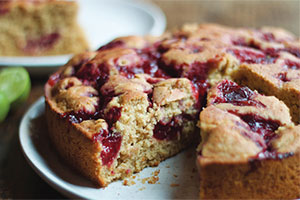The Vegan Patch - Celebrate the Cruciferous

Superstar veganic gardener, Sarah Oliver, lays down her tips for those looking to grow their own ‘super-veggies’ from the cruciferous family.
If you’ve been vegan for a while, or if you’ve been on any sort of health kick, it’s likely you’ve come across someone highlighting the benefits of cruciferous vegetables. The most familiar in this group are vegetables like brassicas; broccoli, pak choi, cabbage, cauliflower. However, there are many others, including the much touted rockstar vegetable, kale; the more unusual kohlrabi; and my current favorite, the nutrition powerhouse collard greens.
Eating these vegetables is one thing, but growing them can leave you feeling a little underwhelmed. Broccoli hit by white butterflies, kale covered in whitefly, and seedlings demolished by slugs and snails, as well as small, sad looking plants that can leave you questioning your gardening skills. Is it even possible to grow these vegetables using veganic principles? Much advice centers around manures, slug bait, and blood and bone. But incorporating some key principles can be a game-changer.
Crop rotation
Vegetables require different levels of soil fertility. By rotating crops around and incorporating cover crops and compost, the heaviest feeders like brassicas can go into a more fertile part of the rotation cycle, followed by ones that require less. Another advantage of crop rotation is that it helps to reduce disease pressure. Even in a very mixed planting style, some form of crop rotation of annuals can help soil health.
Ideally, leave a gap of three to four years between main crop families. In raised beds, it’s possible to plant different families in each bed and rotate them between the beds. If there is space, start each crop rotation cycle with a green manure crop.
We use a mixed cover crop including clover and later add in mustard. We leave this in for 18 months and it acts to grow the soil microbiology; we cut and drop the cover crop multiple times during this phase. But even just one season using a cover crop, like lupins, to build fertility and adding compost can help to get the soil humming. After this initial cover crop, put in the heavy feeders. I start with potatoes and, once harvested, in go our first late-summer brassica crops. Where there are gaps, pop in short-term vegetables or cover crops where there is space before planting to keep the soil covered.
Mulching
Mulch not only keeps the moisture in supporting soil health, but it also adds to fertility as it breaks down. You can mulch with cover crops, compost, straw, and even weeds (not invasive ones!) and grass. If you have a lot of slugs and snails around then compost is often a better mulch to reduce the pressure, but it can get expensive, so we use a range of materials. If you mulch with hay, which is likely to contain weeds, then turn it over to suppress the weeds as they emerge.
Seeds and seedlings
One key element to successful cruciferous vegetables is growing robust seedlings. Experiment with different seeds and know that even the most experienced grower has suffered seed varieties that don’t do so well in their garden. Weather, climate, and soil temperatures all play a part.
Some more simple crops, like rocket and mizuna, can go straight in the ground for some fast salad greens. But for others you’ll need to grow as seedlings first and the stronger the better, so they are less tempting to slugs and snails.
Most, like broccoli, collards, cabbage, and kale, need extra care before they go into the garden bed. If you are raising from seeds yourself, plant them into trays first, then pick them out when they have their first true leaves — the second pair of leaves — and then repot them into larger, deeper trays or individual pots. The extra boost at each stage gives them a shot of extra fertility as well as extra space and the plants develop a good root system before they go into the ground. Wait until they are about 8-10cm before planting out.
Work on your compost skills
We use a seaweed fertilizer for our brassicas when they are establishing in the ground to give them a boost, but as the soil and our compost-making improves, we find we need less and less fertilizer. So, work on your compost skills. This I cannot say enough. We now grow all our seedlings in our own sifted compost, and it is rich in microbiology and the seedlings just thrive. We’ve spent quite a while perfecting this, so if you can, try to get a compost heap underway.
Cover your crops and choose your timing
Netting is essential when growing broccoli, cabbages, collards, and kale in our gardens. Where we live, we find we can plant seeds in early spring and again in late January through autumn to establish the plants before the cooler months. When the while butterflies are around we keep the seedlings covered with netting as seedlings and also when in the ground until we hit cooler temperatures and the white butterflies are gone.
There are also plants which help repel white butterflies, and diversity in the garden creates habitat for beneficial insects in even the smallest garden. But with many brassicas, I find covers are still essential.
So get out your garden plan, winter is here and it may seem super early, but now is the time to start thinking about getting your early seeds in and planning some rotation planting for next year.
Happy growing and eating!
Aotearoa Vegan and Plant Based Living Magazine
This article was sourced from the Winter 2022 edition of The Vegan Society magazine.
Order your own current copy in print or pdf or browse past editions.
Disclaimer
The articles we present in our magazine and blog have been written by many authors and are are not necessarily the views and policies of the Vegan Society.
Enjoyed reading this? We think you'll enjoy these articles:
What’s in a Trademark?
What’s in a Trademark? 29 March 2024 The Vegan Society As more companies start to become more aware of the ingredients in …
NZ Vegan Chocolate Awards 2024
2024 NZ Vegan Chocolate Awards 25th March 2024 The Vegan Society One of the most wonderful foods our planet has to offer …
Plum and Lime Cake
Liked this? We think you’ll enjoy these recipes: Katsu Tofu Katsu Tofu The Vegan BBQ The Vegan BBQ 1 2 3 … …




